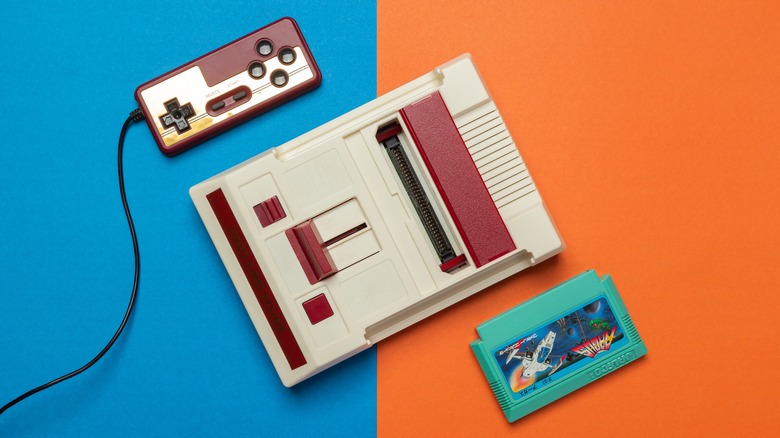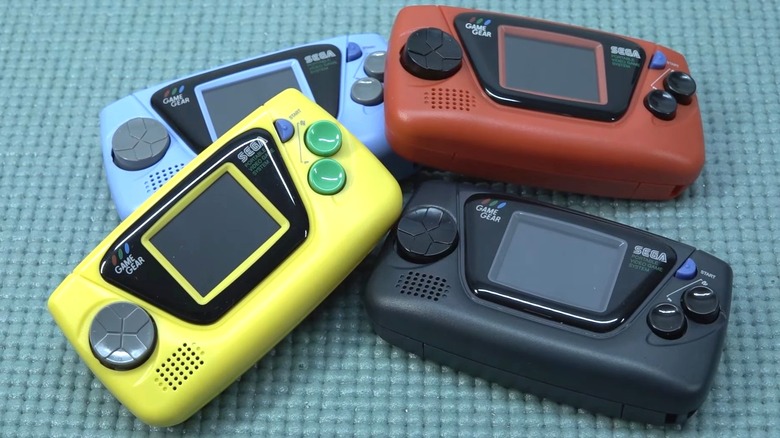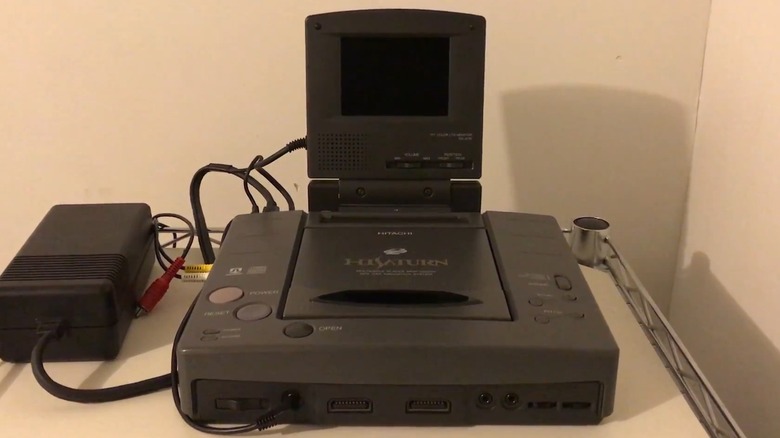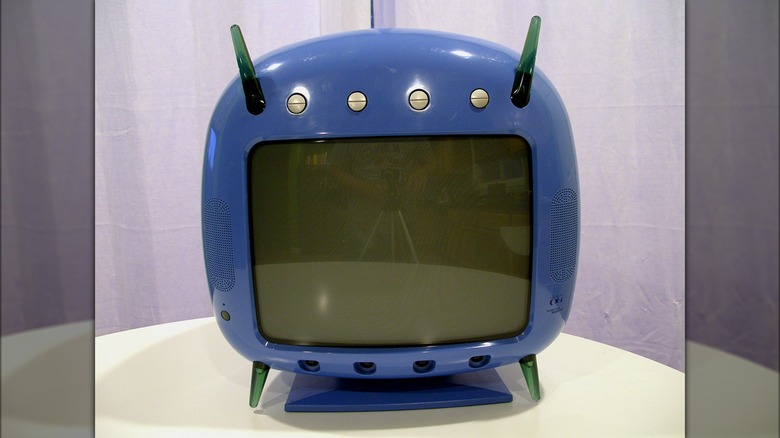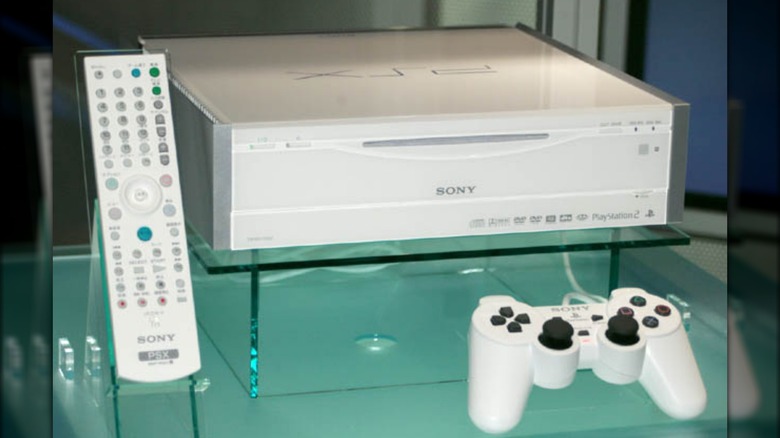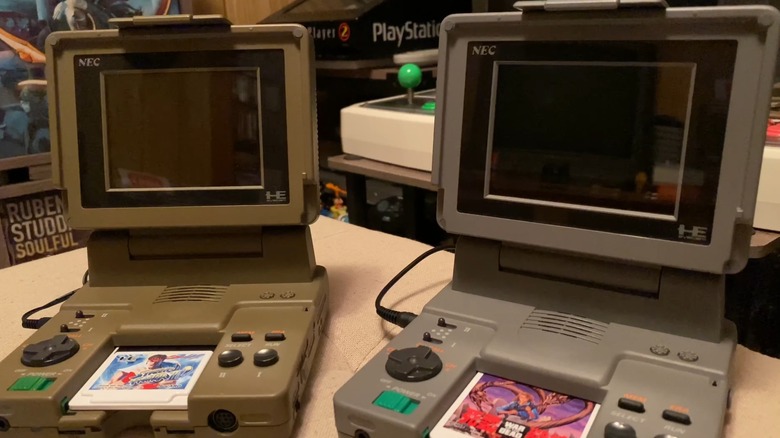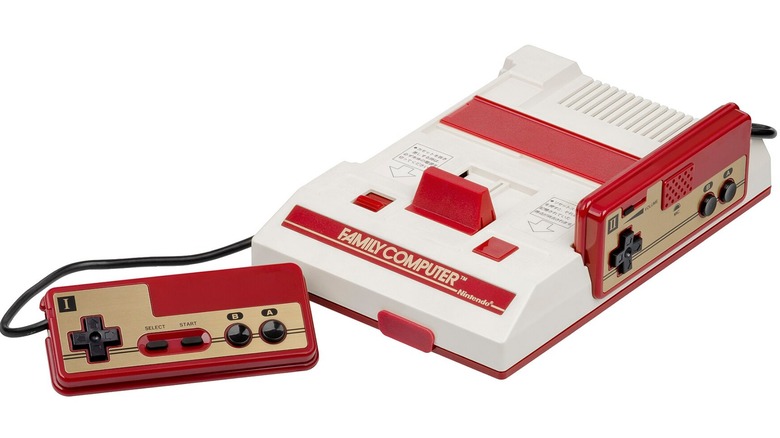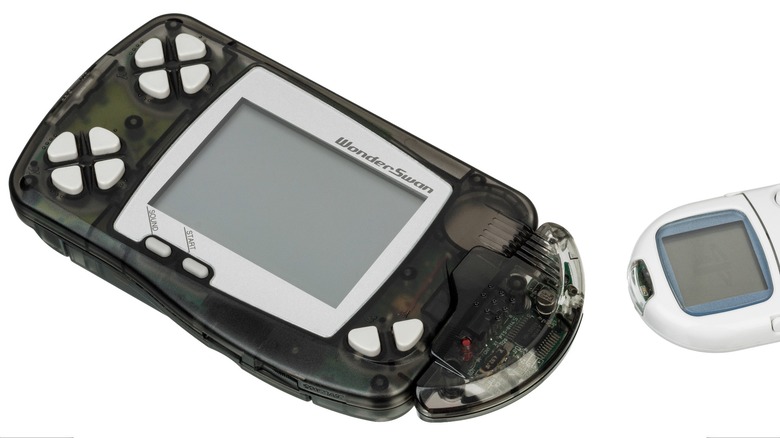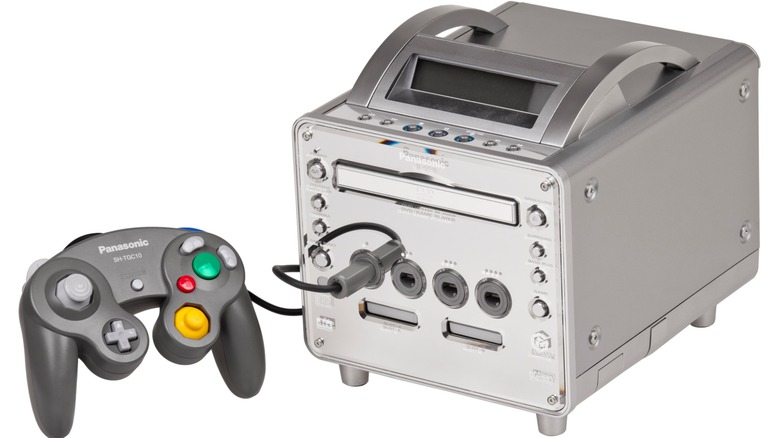8 Of The Best Gaming Consoles That Were Never Released Outside Of Japan
Japan is the mecca of video games. The country essentially jumpstarted the video game industry, so it is obviously home to some of the largest and longest-lived studios, many of which develop games for Japanese audiences first and everyone else second. While some gaming sensibilities are universal, regional preferences have led to some strange collector's editions and ultra-rare controllers that never made it to the North American or European markets. That also applies to video game consoles.
While most Japanese-developed consoles are released overseas, quite a few have stayed in their home country. Perhaps sales numbers of previous consoles convinced manufacturers they shouldn't risk overseas sales, or perhaps a company wanted to port a console to the U.S. but chickened out. No matter the reason, Japanese gamers got their hands on consoles nobody else did, and while not every Japan-exclusive console was worth having, some might have actually done well stateside due to their features or library.
Here are some of the best Japanese game consoles you probably wish you could have had growing up.
Game Gear Micro
Nintendo's NES Classic proved a rousing success. Audiences loved the console's collection of classic games and tiny form factor. This palm-sized console was followed by the SNES Classic, while Sony and Sega tried to grab a piece of the retro-flavored pie with the PlayStation Classic and Sega Genesis Mini, respectively. While Sega is launching a second Genesis mini, the company shows no signs of porting a mini based on its beloved handheld.
In October 2020, Sega released the Game Gear Micro exclusively in Japan. The premise is the same as the other miniaturized consoles — cram nostalgia into a tiny package. Priced at 4,980 yen (approximately $40), the Game Gear Micro included four classic games such as "Sonic the Hedgehog." Not only was the Game Gear Micro one of the smallest classic consoles out there, but unlike similar devices, Sega sold four different versions with varying colors and libraries. If you wanted "Sonic Chaos," you had to buy the blue version, but if you had a hankering for "Shinobi," you needed the red rendition.
While the Game Gear Micro family was solidly constructed and boasted a decent game library, each was smaller than a Game Boy Micro and had some of the tiniest screens of any dedicated game console. Trying to play "Shining Force" on the Game Gear Micro was like trying to play "Fire Emblem" on a Tomagotchi, at least until you used the free (and color-coordinated) screen magnifier included with each Game Gear Micro.
Hitachi Game & Car Navi HiSaturn
While the Sega Saturn didn't really take off in the US, it was popular in Japan, likely due to the explosive commercials featuring the fictional Segata Sanshiro (played by the legendary tokusatsu actor Hiroshi Fujioka). Maybe if Sega of America had advertised the Saturn with commercials starring Chuck Norris, the U.S. version might have sold well enough to receive a variant designed for car rides.
The Hitachi Game & Car Navi HiSaturn was the result of a collaboration between Sega and Hitachi that was essentially a Sega Saturn with a vehicular twist. Instead of plugging into a wall outlet, it plugged into a car's cigarette lighter. The HiSaturn couldn't use any other power sources, but it included ports for karaoke microphones, a GPS antenna, and a TV tuner. Aside from those additions, it was a regular Sega Saturn and could play all the classic Saturn titles you know and love.
Since the HiSaturn was a semi-portable platform, one might assume it included a TV screen so users could play on the go. Well, that is half right. Sega sold a separate, foldable LCD screen that could plug into the HiSaturn, but if you didn't own one, the Hitachi Game & Car Navi HiSaturn could plug into car-mounted televisions.
Two-in-one TVs
Setting up game consoles used to be a huge hassle. Sure, nowadays you have to connect them to the internet, link your consoles to accounts, and install updates, but that is nothing compared to the frustration of old-school cable management. Some manufacturers decided to solve this problem by hard-wiring consoles into televisions.
Japanese gamers could purchase quite a few two-in-one TV/console hybrids. One of the most notable examples was the Dreamcast Divers 2000 CX-1, which was a Dreamcast built into a TV shaped vaguely like Sonic the Hedgehog's head. The setup included all the peripherals that came with a vanilla Dreamcast, as well as an additional keyboard so audiences could surf the Dreamcast's web browser or play "Phantasy Star Online."
The Dreamcast Divers wasn't an example of Sega doing something that Nintendo didn't, as Nintendo worked with Sharp to produce its own TV/console hybrids, the Super Famicom Naizou TV SF1 and the C1 NES TV. However, Sega did develop a unique computer/console hybrid. The Teradrive was part IBM PC, part Sega Megadrive (the non-US name for the Sega Genesis) — all gaming platform. The Teradrive was developed as a budget device, but it failed due to its non-budget price. While Sega teamed up with IBM to produce the Teradrive, the company also collaborated with Amstrad to create a similar, but still technically different, Amstrad Mega PC for the UK.
[Featured image by Chris Ainsworth via Wikimedia Commons | Cropped and scaled | CC BY-SA 2.0]
PSX
The PlayStation 2 is the best-selling console of any generation, which is an impressive feat given Sony entered the gaming business late with its original PlayStation. Many gamers see the PlayStation 3 as the start of Sony pivoting their game consoles towards multimedia roles, but that is only true outside of Japan.
In 2003, Sony launched the PSX, which was essentially an oversized PS2 with DVR capabilities. Or was it an oversized DVR with PS2 functionality? Nobody knows for sure since rumors state it was originally supposed to be just a DVR until Sony added PS2 components last minute. Since Sony marketed the system itself — instead of advertising it through the company's PlayStation branch — that's not an unreasonable assumption.
Sony produced eight different PSX models, each with different combinations of ports, hard drive storage space, and PlayStation Portable connectivity. While the PSX could play PlayStation and PS2 games, record shows, and burn the recordings onto discs, the PSX couldn't play CD or DVD discs, at least until those features were added via firmware updates. A 2005 article from IGN claimed the PSX failed because its target audience viewed the device as superfluous. Still, redundant or not, we can at least thank the PSX for prototyping some features for the PlayStation 3 — the PSX, not the PS3, was the first console to use the Cross Media Bar user interface menu.
[Featured image by Moi via Wikimedia Commons | Cropped and scaled | Public Domain]
PC Engine LT
The TurboGrafx-16, better known outside of the U.S. as the PC Engine, was an underappreciated gem of a fourth-generation console. NEC Home Electronics and Hudson Soft combined an 8-bit CPU with two 16-bit GPUs to create some of the best-looking games of the time. Unlike rival companies, the PC Engine's manufacturers had two ideas on how to make their console portable, one of which never left Japan.
In 1991, NEC and Hudson Soft released the PC Engine LT for Japan only. Unlike its predecessor, the PC Engine GT (TurboExpress in the U.S.), the LT wasn't a handheld but a portable console. What's the difference? The PC Engine LT came with its own folding screen and required an external power source. This might sound like a downgrade, but given the GT's abysmal battery life, this reliance was more like an upgrade.
While the PC Engine LT's single controller was built into the console, unlike the PC Engine GT, it was compatible with all normal PC Engine add-ons and their games. This design gave players a larger library than PC Engine GT owners, which is saying something since PC Engines were already home to fantastic games, many of which were near-flawless ports of arcade titles. By all accounts, the PC Engine should have flourished outside of Japan; at least then Western audiences could have received a PC Engine LT.
Famicom
Before you say anything, yes, Nintendo released a console outside of Japan and called it the Nintendo Entertainment System (NES), but technically speaking differed from the Famicom in several key aspects and could be considered a separate platform. At the very least, these differences are more substantial than the ones that separate "Super Mario Bros. 2" and "Doki Doki Panic."
The Famicom is immediately recognizable when placed next to the NES. The Japanese console sported a different color palette (red and white instead of grays and black), and its controllers were hardwired into the console itself. Moreover, while internationally-released games were functionally similar to the Japanese originals, their cartridges were incompatible with the Famicom and vice versa.
However, some exceptions to the game systems rule cropped up here and there due to the microphone built into the Famicom's second controller. Games initially programmed with voice functionality needed that feature removed when localized for other markets. The original "The Legend of Zelda" is a prime example since, in the Japanese version, Pols Voice enemies could be vanquished by yelling into the microphone. Since the NES didn't have one, that weakness was changed to arrows.
Furthermore, unlike the NES, Nintendo supported the Famicom with add-ons and alternate versions. You might already know about the Famicom Disk System that let audiences play games from floppy disks, but did you know Nintendo worked with Sharp to produce a Famicom model known as the Sharp Twin Famicom that included a cartridge and disk reader in one plastic shell? Or that Sharp and Nintendo produced a Famicom designed to capture game footage? Sharp and Nintendo really spoiled Japanese gamers, didn't they?
[Featured image by Evan-Amos via Wikimedia Commons | Cropped and scaled | Public Domain]
Bandai Wonderswan
Gunpei Yokoi was the mastermind behind the Nintendo Game Boy and the D-pad. Without him, Nintendo probably wouldn't have a stranglehold on handheld video games. After he left Nintendo, Yokoi went to work for Bandai and helped create the company's most popular handheld devices — the Tamagotchi and the Wonderswan.
While almost everybody knows about the Tamagotchi, the Wonderswan was a fascinating device that never left Japan. For starters, the handheld ran on a single AA battery — even Nintendo's Game Boys required at least two AAs. The Wanderswan was also one of gaming's only dedicated platforms capable of running titles in either landscape or portrait mode. Of course, even the most impressive pieces of gaming hardware are little more than expensive paperweights if they don't have any good games to play, but the Wonderswan had plenty, including quality titles such as "Final Fantasy" ports.
The Wonderswan might have been Bandai's final game console, but it was also the company's most successful. This handheld outsold all of its rivals with the exception of Yokoi's other brainchild, the Game Boy — the Game Boy Color and Advance to be precise. Bandai planned to release the Wonderswan in the U.S., but Nintendo had entrenched itself so thoroughly into the country's handheld gaming scene that Bandai got cold feet. The general gaming landscape could have altered significantly had Bandai given the Wonderswan the same chance it gave Tamagotchi and Digimon.
[Featured image by Evan-Amos via Wikimedia Commons | Cropped and scaled | Public Domain]
Panasonic Q
The sixth generation of consoles was a critical era for gaming. It was the time of the PlayStation 2, Xbox, and Gamecube — when people started to take video games seriously. This generation also initiated a new console war between Sony, Nintendo, and Microsoft. Nintendo started this battle off on the wrong foot due to the Gamecube's inability to play DVDs — outside of Japan, that is.
To solve this multimedia misstep, Nintendo partnered with Panasonic to produce the Panasonic Q. This Japan-exclusive console maintained the Gamecube's lunchbox aesthetic but was larger to fit the stand-sized disc tray. Moreover, while the Gamecube came in a rainbow of bright colors, the Panasonic Q's finish was a universal shiny gunmetal silver, but at least the controller ports lit up.
While the Panasonic Q was more expensive than the vanilla Gamecube, the higher price tag was worth it because the console could play regular-sized DVDs and even CDs in addition to the Gamecube's proprietary mini discs. However, since the Panasonic Q was limited to Japan, it could only play Japanese DVDs and CDs. Later, import shops started selling even more expensive modified, non-region locked Panasonic Qs. Despite fixing the Gamecube's most glaring problem, the Panasonic Q didn't sell well, which might explain why Nintendo's consoles never became multimedia platforms, unlike their competitors. Not that it's hurt them.
[Featured image by Evan-Amos via Wikimedia Commons | Cropped and scaled | CC BY-SA 3.0]
